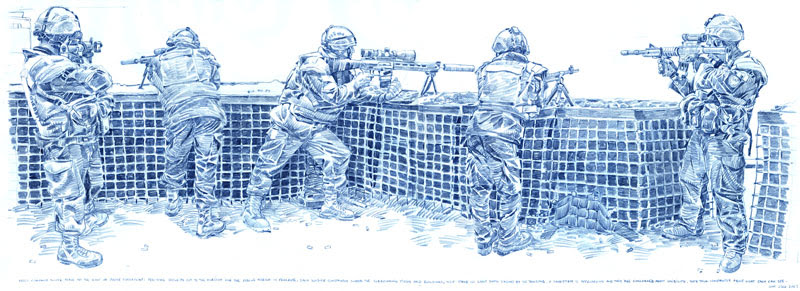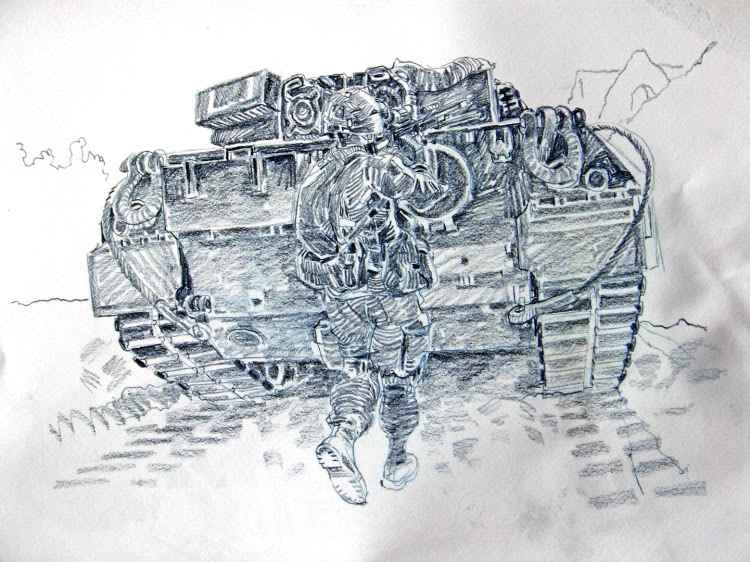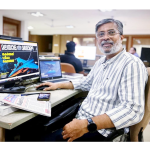
“Johnson draws in the field, sparking an immediacy and freshness that traditional war illustrations lack . . . he never goes back to it, or fill it in, and do the ‘prettying up’ that other artists do . . . he captures the everyday reality of life on the ground through this more raw artistic approach”.
JENNIFER LOCKE JONES, CURATOR OF THE SMITHSONIAN MUSEUM OF ARMED FORCES HISTORY
2004: JOSEPH L. GALLOWAY, Author of “We Were Soldiers Once … and Young”
2007: MICHAEL D. FAY, Chief Warrant Officer-2 and USMC Artist-in-Residence
“I not only congratulate you but also the young writer who shared your experience … you both were sensitive and caring – the real touchstones of life.”
2004: HOWARD BRODIE, Veteran Combat Artist
Richard’s work, from the Iraq invasion and the war in Afghanistan, is now held by the Smithsonian National Museum of American History, in Washington, D.C. “I was taught to draw by my grandfather. He started by teaching me to draw the shapes around things rather than the things themselves. This is a technique I still fall back on today when I am struggling with proportions. For me, drawing is about getting people to pay attention to something – to something they need to see clearly, to something studied and dissected and rendered and understood. So I draw. I draw what I see. I use that limited drawing skill, to hopefully stun people out of their daily reverie.My grandfather’s spirit travels with me still.”
He lives in Toronto with his wife and children. He works as Graphics Editor and news illustrator for Canada’s National Post. T K Sajeev talks exclusively with Richard Johnson for www.newspaperdesign.in
1. In Asia, news illustrations from the field is very very rare. The national post has been doing it so consistently. Can you explain the role of news illustrations, from the field, in a newspaper and also a brief history of it?
In 2003 in the months leading up to the U.S. Invasion of Iraq, I spent a couple of days with War Artist Howard Brodie. Brodie was a true war artist something I will never consider myself. He had landed at Normandy in WW2. Got himself trapped with the GIs during the Battle of the Bulge. He landed with the Marines at Guadalcanal. And was there in Korea in the 50’s, and I again n Vietnam in the 60’s and 70’s. For a budding field artist, it was like visiting a God.
Brodie invited me into his home and we talked about what I was likely to experience in Iraq. I left after my days with him with a couple of key ingredients that continue to serve me well in all my fieldwork. First, he gave me my first Prismacolor pencil. The pencil is ideally suited to field sketching. It doesn’t rub off. When you put a line down it stays down through rain, sweat and friction. Great for drawing in crappy conditions – terrible if you make a mistake. (Brodie had originally stolen them from a company CP when he lost everything over the side of a landing USMC craft at Guadalcanal). Secondly, he gave me a single piece of advice that stays with me in everything I do. He told me to suspend my judgment of whoever I draw and just to draw. He told me that through my accuracy in representation of an individual I will capture far more than anything I can put into it of myself. So there is little of art in what I do. I am a documenter. I just use a pencil instead of a camera.
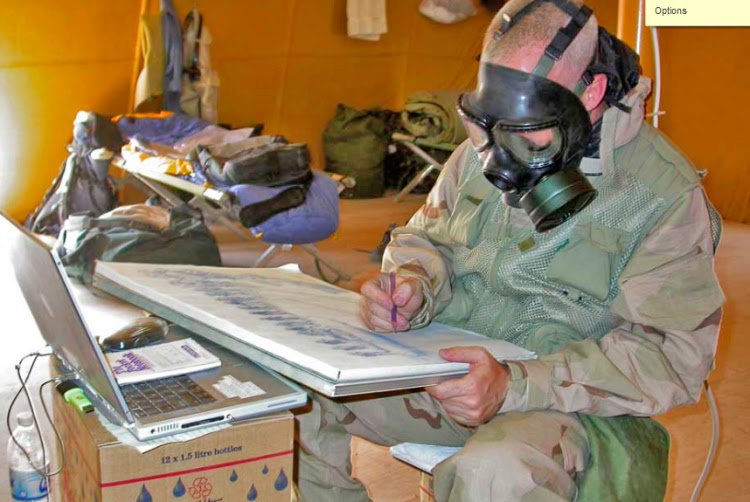
Richard johnson sketching during the Iraq war field
2. While illustrating from the field what are details one should not miss to include?
Kind of answered this in the previous question. I draw what I see. I draw live on a possible occasion. When I have to draw from photography – when things are moving too fast, or it is too dangerous – I draw from them within 24 hours. I never look at it again.
3. What are the research work an illustrator has to do before getting into the field?
Well, a healthy world knowledge is a start. After that, it is just talking about your day to day existence and what you see. The illustrations come naturally. If something interests me, then I draw it and talk about it. I consider myself the “everyman” so if it interests me I figure it will interest everyone. Much of the reader response to my work is from people who love the first person narrative.
As far as artistic preparation goes – most of the time I don’t draw very much, so – I have to kick my drawing skills up into high gear in the months ahead of shipping out. Lots of life-drawing classes and speed tests. Lots of sketching 30-second and 60-second model poses.

4. You have done lot of news illustrations from Afghanistan war front.How risky was it and what are the preparations you have done for it?
The risks you take as a journalist are the same as the soldiers take – except they take them for nine months, and you take them for six weeks or so. For soldiers in Afghanistan that meant lots of patrolling and occasionally coming under fire. Rocket attacks and the odd mortar while in bases and the constant risk of IED’s either on foot or in a vehicle. But if you want to tell stories about the soldiers day-to-day though, you have to walk in their shoes day after day.
I have never taken any military training other than first aid. When I am out I just do what the soldiers do. When they duck, I duck faster. And I don’t pick anything up or wander off.
5. What is the future of news illustrations from the field as compared to information graphics?
Two totally different questions with very little overlap. Field reportage or news illustration has a bright future. People are absorbed by details in a drawing in a different way than they are with a photograph. They are drawn in and want to know much more. For me it has always been about telling stories. The drawings make people want to read the stories I write.
Information graphics for me is what I do in my day job so that I can eventually get out of the office. That does not mean that I am not good at my job, but comparing them is very difficult. With graphics the future is morphing – for me there are two schools now. The heavily data driven, coded display of information – which very few people are doing well, and the data visualization “still” infographics that we create regularly with little-or-no interactivity.
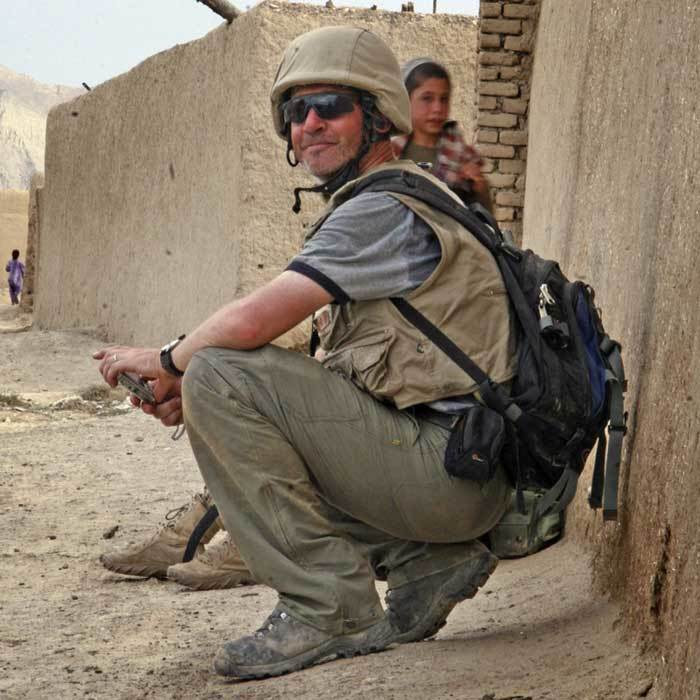
Working for Canada’s National Post, embedded with Canadian Forces in Afghanistan. On patrol through a small village in the Arghandab valley near Panjwaii. May 2007.
6. Which is more interesting – information graphics or news illustrations from the field – for you? Why?
No comparison. The field work. It is essential in telling stories in a newspaper to get out of the building and experience the world you are writing/drawing/graphing. I make sure that my artists get out and visit archives, accidents and construction sites to see first hand what it is they are building back in the office at their desk.
7. Though information graphics and news illustration from the field were quite different in your opinion, which one grabs the readers attention most? Why?
No comparisons, they both grab different audiences in entirely different ways.
8. Do you think a full page or a centre-spread information graphics is providing too much information to the readers that he/she skip away from it because of their busy schedule?
Nope. Generally, our full-page graphics run on a weekend. People love to immerse themselves in a graphic which displays all of the information so they can decide for themselves what they think about a topic, rather than a story where a writer decides what will be told.
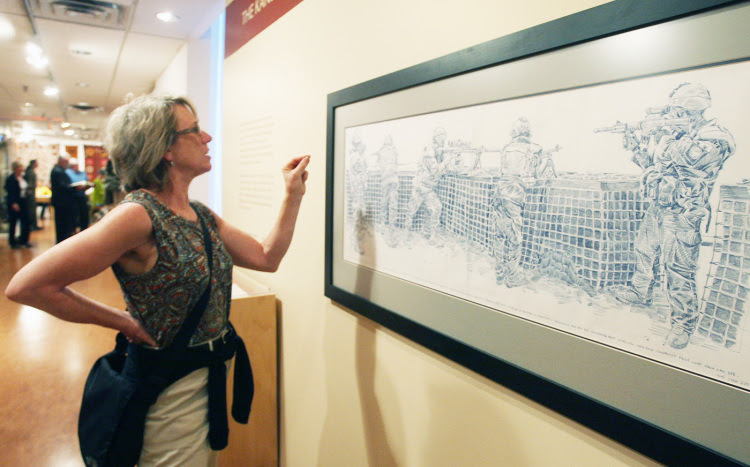
Exhibition: War field illustrations
9. What is your concept of a good information graphics?
Easy. Get good data. Get good, relevant, up-to-the-minute data and display it without distortion or gimmick. The graphic artist’s job is to allow the viewer to see patterns within the data that would not be apparent unless viewed in a specific way – not to hide it or distort it. Data accuracy and data representation accuracy are sacred.
10. Is today’s information graphics in the right direction?
No idea. I keep up with what is going on and at times I am disheartened by what I see being called an information graphic, or a data visualization. There are some heinous crimes out there being committed, but there is also some great work. I’d say that many of us are trying to stay afloat and keep our jobs. So there is a tendency to accept directions that you would rather not accept, and that is leading to some ugly graphics indeed.
11. Do you prefer to use templates for information graphics or do you prefer to approach each one according to the demand of the subject?
I am a big believer in setting rules and templates that everyone should work incredibly hard to stick to, unless they don’t work. This hopefully allows a little window of freedom, but generally the creativity of making it work within the template form keeps us all equal and makes us look like a single entity. The reader sees the pattern and knows what to expect.
12. Is there any censorship for the war field illustration?what kind?
In all of my time as an artist in theatre I have never been censored, or asked not to draw or write about something. The only guideline given is to avoid saying anything that might upset operational security. Which if you have any sense of self preservation at all is obviously something you would want to avoid. I write what I see, I draw what I see, no restrictions other than daylight and energy.
13. For a beginner,How he can be a part of the war field illustration?What are the procedures?
Most of the militaries run some kind of war art program if art is your thing. If journalism is your thing it is a matter of finding an embedding spot with whoever you are interested in. You need a sponsored publication and you need a whack of extra life insurance. These are the difficult things to get on your own unless you are sponsored by a major news outlet. For afghanistan you can ember through NATO and ISAF or though individual countries involved.
14. Tell about your proud moment in the field of news illustration?
I think probably my most worthwhile work has been telling stories of those left behind after the war. The widows and the wounded. It was a privilege to b given the opportunity to tell those stories.
Visit
newsillustrator.com
tweet @newsillustrator
![]()

